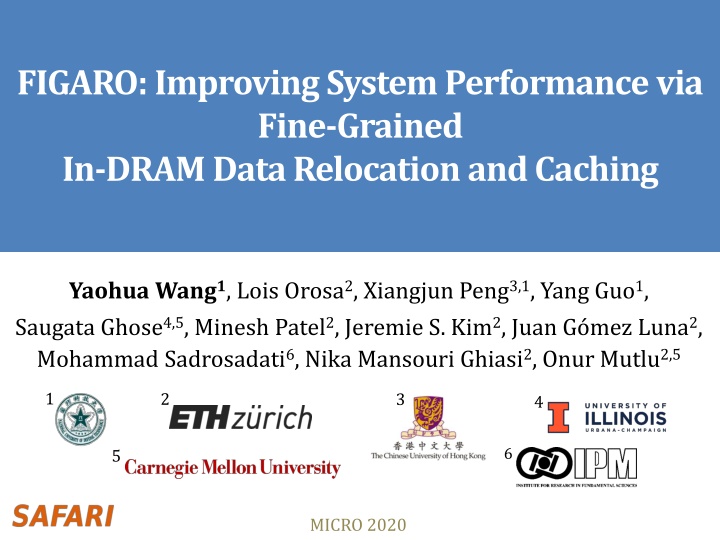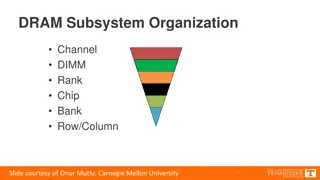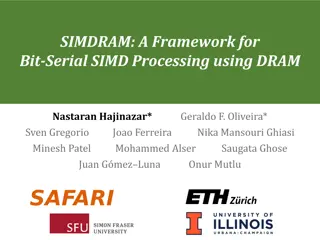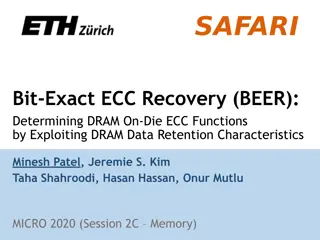
Enhancing System Performance with Fine-Grained In-DRAM Data Management
Learn about FIGARO, a system designed to reduce DRAM latency through in-DRAM caching and data relocation. FIGCache optimizes memory access by caching specific row segments, resulting in a 16.3% improvement in system performance and 7.8% reduction in energy consumption on average. Explore the details of this innovative solution and its impact on system efficiency.
Download Presentation

Please find below an Image/Link to download the presentation.
The content on the website is provided AS IS for your information and personal use only. It may not be sold, licensed, or shared on other websites without obtaining consent from the author. If you encounter any issues during the download, it is possible that the publisher has removed the file from their server.
You are allowed to download the files provided on this website for personal or commercial use, subject to the condition that they are used lawfully. All files are the property of their respective owners.
The content on the website is provided AS IS for your information and personal use only. It may not be sold, licensed, or shared on other websites without obtaining consent from the author.
E N D
Presentation Transcript
FIGARO: Improving System Performance via Fine-Grained In-DRAM Data Relocation and Caching Yaohua Wang1, Lois Orosa2, Xiangjun Peng3,1, Yang Guo1, Saugata Ghose4,5, Minesh Patel2, Jeremie S. Kim2, Juan G mez Luna2, Mohammad Sadrosadati6, Nika Mansouri Ghiasi2, Onur Mutlu2,5 1 2 3 4 6 5 MICRO 2020
Executive Summary Problem: DRAM latency is a performance bottleneck for many applications Goal: Reduce DRAM latency via in-DRAM cache Existing in-DRAM caches: Augment DRAM with small-but-fast regions to implement caches Coarse-grained (i.e., multi-kB) in-DRAM data relocation Relocation latency increases with physical distance between slow and fast regions FIGARO Substrate: Key idea: use the existing shared global row buffer among subarrays within a DRAM bank to provide support for in-DRAM data relocation Fine-grained (i.e., multi-byte) in-DRAM data relocation and distance-independent relocation latency Avoids complex modifications to DRAM by using (mostly) existing structures FIGCache: Key idea: cache only small, frequently-accessed portions of different DRAM rows in a designated region of DRAM Caches only the parts of each row that are expected to be accessed in the near future Increases row hits by packing frequently-accessed row segments into FIGCache Improves system performance by 16.3% on average Reduces energy consumption by 7.8% on average Conclusion: FIGARO enables fine-grained data relocation in-DRAM at low cost FIGCache outperforms state-of-the-art coarse-grained in-DRAM caches 2
Outline Background Existing In-DRAM Cache Designs FIGARO Substrate FIGCache: Fine-Grained In-DRAM Cache Experimental Methodology Evaluation Conclusion 3
DRAM Organization Subarray Bitline Bank DRAM Cell Wordline Chip I/O . . . Local Row Buffer Global Row Buffer DRAM Subarray DRAM Bank DRAM Chip 4
Outline Background Existing In-DRAM Cache Designs FIGARO Substrate FIGCache: Fine-Grained In-DRAM Cache Experimental Methodology Evaluation Conclusion 5
Inefficiencies of In-DRAM Caches 1) Coarse-grained: Caching an entire row at a time hinders the potential of in-DRAM cache 2) Area overhead and complexity: Many fast subarrays interleaved among normal subarrays 6
Outline Background Existing In-DRAM Cache Designs FIGARO Substrate FIGCache: Fine-Grained In-DRAM Cache Experimental Methodology Evaluation Conclusion 7
Observations and Key Idea Observations: SRC: Subarray A A0 A1 A2 A3 A3 1) All local row buffers (LRBs) in a bank are connected to a single shared global row buffer (GRB) A4 A5 A6 A7 Local Row Buffer (LRB) 2) The GRB has smaller width (e.g., 8B) than the LRBs (e.g., 1kB) 1kB DST: Subarray B GRB B0 B1 B2 B3 Key Idea: use the existing shared GRB among subarrays within a DRAM bank to perform fine-grained in-DRAM data relocation 8B B4 B5 B6 B7 Local Row Buffer (LRB) 8
FIGARO Overview FIGARO: Fine-Grained In-DRAM Data Relocation Substrate Relocates data across subarrays within a bank Column granularity within a chip Cache-block granularity within a rank 9
Key Features of FIGARO Fine-grained: column/cache-block level data relocation Distance-independent latency The relocation latency depends on the length of global bitline Similar to the latency of read/write commands Low overhead Additional column address MUX, row address MUX, and row address latch per subarray 0.3% DRAM chip area overhead Low latency and low energy consumption Low latency (63.5ns) to relocate one column Two ACTIVATEs, one RELOC, and one PRECHARGE commands Low energy consumption (0.03uJ) to relocate one column 10
Outline Background Existing In-DRAM Cache Designs FIGARO Substrate FIGCache: Fine-Grained In-DRAM Cache Experimental Methodology Evaluation Conclusion 11
FIGCache Overview Key idea: Cache only small, frequently-accessed portions of different DRAM rowsin a designated region of DRAM FIGCache (Fine-Grained In-DRAM Cache) Uses FIGARO to relocate data into and out of the cache at the fine granularity of a row segment Avoids the need for a large number of fast (yet low capacity) subarrays interleaved among slow subarrays Increases row buffer hit rate FIGCache Tag Store (FTS) Stores information about which row segments are currently cached Placed in the memory controller FIGCache In-DRAM Cache Designs Using 1) fast subarrays, 2)slow subarrays, or 3) fast rows in a subarray 12
Benefits of FIGCache Fine-grained (cache-block) caching granularity Low area overhead and manufacturing complexity 13
Outline Background Existing In-DRAM Cache Designs FIGARO Substrate FIGCache: Fine-Grained In-DRAM Cache Experimental Methodology Evaluation Conclusion 14
Experimental Methodology Simulator Ramulator open-source DRAM simulator [Kim+, CAL 15] [https://github.com/CMU-SAFARI/ramulator] 8 cores, DRAM DDR4 800MHz bus frequency Workloads 20 eight-core multiprogrammed workloads from SPEC CPU2006, TPC, BioBench, Memory Scheduling Championship Comparison points Baseline: conventional DDR4 DRAM LISA-VILLA: State-of-the-art in-DRAM Cache FIGCache-slow: Our in-DRAM cache with cache rows stored in slow subarrays FIGCache-fast: Our in-DRAM cache with cache rows stored in fast subarrays FIGCache-ideal: An unrealistic version of FIGCache-Fast where the row segment relocation latency is zero LL-DRAM: System where all subarrays are fast 15
Outline Background Existing In-DRAM Cache Designs FIGARO Substrate FIGCache: Fine-Grained In-DRAM Cache Experimental Methodology Evaluation Conclusion 16
Multicore System Performance Memory intensity Average across all workloads: 16.3% The benefits of FIGCache-Fast and FIGCache-Slow increase as workload memory intensity increases Both FIGCache-slow and FIGCache-fast outperform LISA-VILLA FIGCache-Fast approaches the ideal performance improvement of both FIGCache-Ideal and LL-DRAM 17
FIGARO: Improving System Performance via Fine-Grained In-DRAM Data Relocation and Caching Yaohua Wang1, Lois Orosa2, Xiangjun Peng3,1, Yang Guo1, Saugata Ghose4,5, Minesh Patel2, Jeremie S. Kim2, Juan G mez Luna2, Mohammad Sadrosadati6, Nika Mansouri Ghiasi2, Onur Mutlu2,5 1 2 3 4 6 5 MICRO 2020





















